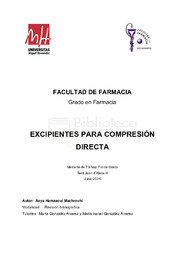Por favor, use este identificador para citar o enlazar este ítem:
https://hdl.handle.net/11000/37324Registro completo de metadatos
| Campo DC | Valor | Lengua/Idioma |
|---|---|---|
| dc.contributor.advisor | González Álvarez, Marta | - |
| dc.contributor.advisor | González Álvarez, María Isabel | - |
| dc.contributor.author | Hamzaoui Machrouhi, Asya | - |
| dc.contributor.other | Departamentos de la UMH::Ingeniería | es_ES |
| dc.date.accessioned | 2025-09-11T12:17:21Z | - |
| dc.date.available | 2025-09-11T12:17:21Z | - |
| dc.date.created | 2025-05-25 | - |
| dc.identifier.uri | https://hdl.handle.net/11000/37324 | - |
| dc.description.abstract | Los comprimidos son la forma sólida más común de administración oral y contienen principios activos junto con excipientes, que cumplen funciones como mejorar estabilidad, biodisponibilidad y seguridad. La fabricación tradicional suele requerir granulación (húmeda o seca) para lograr mezclas homogéneas con buena fluidez, aunque este proceso es costoso, largo y complejo. La compresión directa (CD) es una alternativa más eficiente, donde se mezclan directamente principios activos y excipientes y se comprimen, reduciendo tiempos y costes, y del mismo modo es adecuada a principios activos susceptibles. Requiere de propiedades muy específicas en los excipientes a emplear: buena fluidez, compactabilidad, disgregación y adecuado potencial de dilución. Para ellos se desarrollan excipientes multifuncionales mediante coprocesamiento, combinando dos o más excipientes para mejorar el rendimiento. Por último, la CD es una técnica prometedora que simplifica la fabricación, requiere una formulación optimizada y evaluación cuidadosa. Se apoya en herramientas como Calidad por Diseño (QbD) y simuladores de compresión. | es_ES |
| dc.description.abstract | Tablets are the most common solid form for oral administration and contain active ingredients together with excipients, which serve functions such as improving stability, bioavailability and safety. Traditional manufacturing usually requires granulation (wet or dry) to achieve homogeneous mixtures with good fluidity, although this process is costly, time-consuming and complex. Direct compression (DC) is a more efficient alternative, where active ingredients and excipients are directly mixed and compressed, reducing time and costs, and is also suitable for susceptible active ingredients. It requires very specific properties in the excipients to be used: good fluidity, compactness, disintegration and adequate dilution potential. For them, multifunctional excipients are developed by co-processing, combining two or more excipients to improve performance. Finally, CD is a promising technique that simplifies manufacturing, requires optimized formulation and careful evaluation. It relies on tools such as Quality by Design (QbD) and compression simulators. | es_ES |
| dc.format | application/pdf | es_ES |
| dc.format.extent | 36 | es_ES |
| dc.language.iso | spa | es_ES |
| dc.publisher | Universidad Miguel Hernández | es_ES |
| dc.rights | info:eu-repo/semantics/openAccess | es_ES |
| dc.rights.uri | http://creativecommons.org/licenses/by-nc-nd/4.0/ | * |
| dc.subject | excipientes | es_ES |
| dc.subject | compresión directa (CD) | es_ES |
| dc.subject | principios activos | es_ES |
| dc.subject.other | CDU::6 - Ciencias aplicadas::61 - Medicina::615 - Farmacología. Terapéutica. Toxicología. Radiología | es_ES |
| dc.title | Excipientes para compresión directa | es_ES |
| dc.type | info:eu-repo/semantics/bachelorThesis | es_ES |

Ver/Abrir:
Hamzaoui Machrouhi, Asya.pdf
2,19 MB
Adobe PDF
Compartir:
 La licencia se describe como: Atribución-NonComercial-NoDerivada 4.0 Internacional.
La licencia se describe como: Atribución-NonComercial-NoDerivada 4.0 Internacional.
.png)